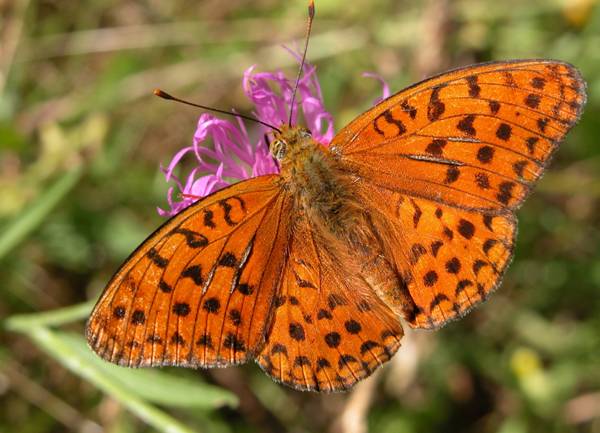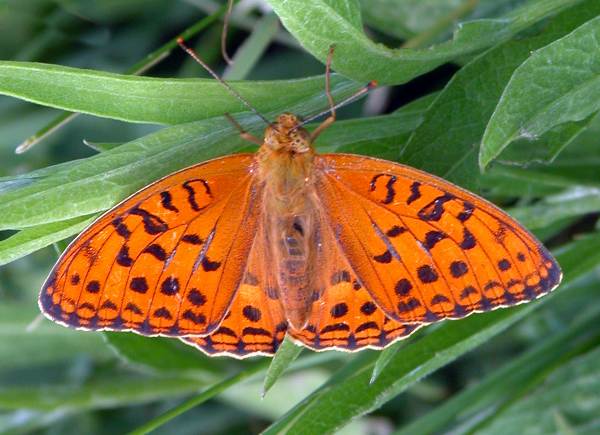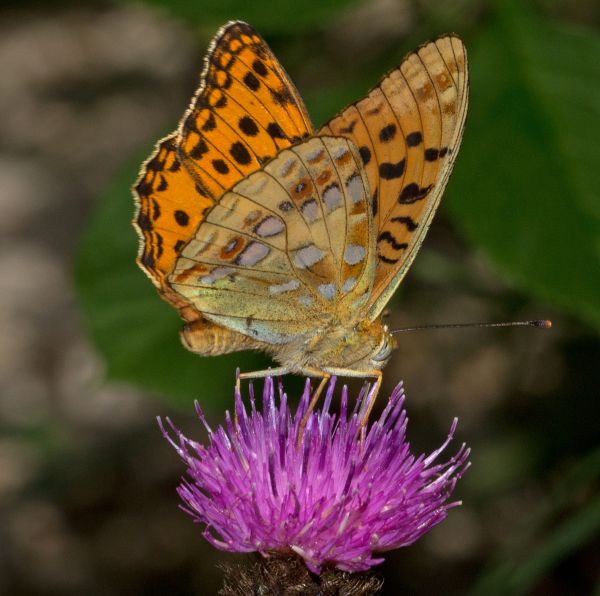Trees Birds Mammals Fish Amphibians Reptiles
Wild Algarve
Bookshop
High Brown Fritillary Butterfly - Fabriciana adippe
Phylum: Arthropoda - Class: Insecta - Order: Lepidoptera - Family: Nymphalidae

The High Brown Fritillary Fabriciana adippe (syn. Argynnis adippe) gets its common name from the arc of brown spots on the undersides of its hindwings, between the outer margin and the silver spangles. Such brown spots are absent from the Dark Green Fritillary. It is a large butterfly, the wingspan ranging from 55 to 69mm, the males being typically smaller and more brightly coloured than the females. A male is shown above, and another male can be seen in the picture below.

A close relative of the Dark Green Fritillary, this beautiful butterfly is Britain's most threatened fritillary, having suffered very serious decline since the 1970s.
Habitat
Bracken-rich moorland and limestone grassland are the habitats favoured (in Britain, at least of this lovely fritillary butterfly.
Distribution
In Britain the High Brown Fritillary is now a very rare sight, being found only in a few scattered locations in the westcountry, Wales and Cumbria.
Elsewhere, the High Brown Fritillary is found in parts of central and southern Europe.

Lifecycle
In common with other large fritillaries, violets (Viola species). including, particularly on woodland edges, Dog Violets Viola riviniana and other violet species are the foodplants of the High Brown Fritillary. In July and August, females lay their straw-coloured eggs singly on the leaves and stems of low-growing plants near to violets. The young overwinter inside the eggs until spring, when the larvae begin feeding on violet leaves before pupating. Adult High Brown Fritillary butterflies emerge in a single brood from late May to late June, flying throughout the summer months.
Acknowledgements
This page includes pictures kindly contributed by Rob Petley-Jones and by Betty and Tony Rackham.
Studying butterflies and moths...
Top of page...
Excited by rivers and streams? So are we, and we're pretty sure you would find the Winding River Mystery trilogy of action-packed thrillers gripping reading too. Dead Drift, Dead Cert, and Dead End are Pat O'Reilly's latest river-based novels, and now they are available in ebook format. Full details on our website here...
Buy each volume in ebook format for only £2.47 on Amazon... Paperbacks also available on Amazon at £6.95 each. All proceeds go towards keeping the First Nature website online.
Please Help Us: If you have found this information interesting and useful, please consider helping to keep First Nature online by making a small donation towards the web hosting and internet costs.
Any donations over and above the essential running costs will help support the conservation work of Plantlife, the Rivers Trust and charitable botanic gardens - as do author royalties and publisher proceeds from books by Pat and Sue.